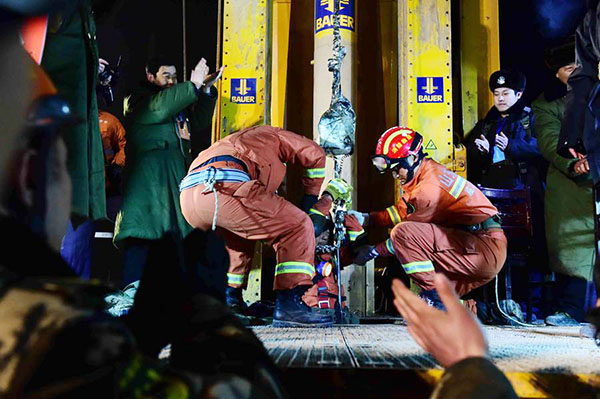Four miners rescued after 36 days trapped in collapsed gypsum mine [1]
30 January 2016Government officials have pledged to improve oversight of the mining industry after four miners were finally rescued from a gypsum mine in Shandong [2] last night, 36 days after the mine collapsed on 25 December 2015.
Following what is believed to be China’s longest-ever rescue operation, the mayor of Linyi, Zhang Shuping, announced a moratorium on all new non-coal mine approvals and detailed checks on the existing 212 mines in the municipality.

One of the four surviving miners is lifted out of the collapsed mine on 29 January. Photo: Xinhua
The collapse occurred at a mine operated by a local company Yurong Trading in Pingyi county. A total of 29 workers were underground at the time, four managed to escape immediately leaving 25 trapped underground. By the evening, another seven miners had been rescued with one worker confirmed dead.
Two days after the disaster, Ma Congbo, the chief executive of Yurong Trading, killed himself by jumping into a mine well during the rescue operation. The Pingyi County Party Secretary, the county head, and two other senior county officials were dismissed from their posts on 29 December for dereliction of duty [3].
The next day, rescuers finally established contact with four of the 17 remaining trapped miners. The rescue teams passed food, clothes, medicine and torches down to the miners while continuing to drill additional ventilation shafts and boreholes. However, attempts to create a tunnel wide enough to extract the miners trapped 200 metres beneath the surface were constantly hampered by additional rock falls and structural hazards. It was not until 27 January, that the authorities were confident that the miners could be saved.
The massive 36-day rescue operation involved hundreds of industry professionals, the army, military police and the fire service. In normal circumstances, it would be the mine owner who picks up the bill for the rescue operation but after Mo Congbo’s suicide that burden fell on the local county, municipal and provincial governments.
Unfortunately, local governments in China seem to spend much more time and resources on responding to major workplace accidents than they do on the enforcement of health and safety standards in order to prevent accidents. In Pingyi county, for example, we know from the explosion at a chemical plant there on 21 October 2015, which killed nine workers and injured two others, that work safety and accident prevention was not a high priority for local officials prior to the gypsum mine collapse.
The mass publicity given to the gypsum mine rescue by national television might force local authorities in Shandong to take work safety more seriously but there is no indication that local government officials in other regions will change their ways.
As CLB noted two weeks ago [4], even after the Tianjin warehouse explosion that killed 173 people on 12 August last year, there was little or evidence of improved work safety measures anywhere in China in 2015.
